Muscularis externa Guides d'étude, Notes de cours & Résumés
Vous recherchez les meilleurs guides d'étude, notes d'étude et résumés sur Muscularis externa ? Sur cette page, vous trouverez 211 documents pour vous aider à réviser pour Muscularis externa.
Page 3 sur 211 résultats
Trier par
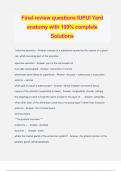
-
Final review questions IUPUI Yard anatomy with 100% complete Solutions
- Examen • 4 pages • 2024
-
Disponible en pack
-
- €9,67
- + en savoir plus
Final review questions IUPUI Yard anatomy with 100% complete Solutions holocrine secretion - Answer- release of a substance caused by the rupture of a gland cell, which becomes part of the secretion apocrine secretion - Answer- part of the cell breaks off true salty sweat gland - Answer- merocrine or eccrine alimentary canal (deep to superficial) - Answer- mucosa > submucosa > muscularis externa > serosa what type of tissue is submucosa? - Answer- dense irregular connective tis...
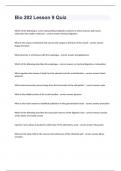
-
BIO 202 Arizona State University -Bio 202 Lesson 9 Quiz well answered graded A+
- Examen • 3 pages • 2024
-
Disponible en pack
-
- €9,21
- + en savoir plus
BIO 202 Arizona State University -Bio 202 Lesson 9 Quiz well answered graded A+Which of the following is a term representing metabolic reactions in which enzymes split macro molecules into smaller molecules - correct answer Chemical digestion What is the mucous membrane that secures the tongue to the floor of the mouth - correct answer lingual frenulum What structure is continuous with the esophagus - correct answer laryngopharynx Which of the following describes the esophagus - correct...
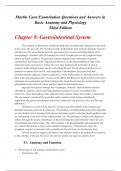
-
Chapter 9: Gastrointestinal System Martin Caon Examination Questions and Answers in Basic Anatomy and Physiology Third Edition
- Examen • 38 pages • 2023
-
Disponible en pack
-
- €6,80
- + en savoir plus
Martin Caon Examination Questions and Answers in Basic Anatomy and Physiology Third Edition Chapter 9: Gastrointestinal System 9.1 Anatomy and Function 1. Which type of cell produces hydrochloric acid? a. Zymogenic cells b. Parietal cells c. Chief cells d. Enteroendocrine cells Answer is B: The parietal cells of gastric glands produce hydrochloric acid. (Zymogenic cells are the same as chief cells, and they produce pepsinogen.) 2. What is the role of gastrin in the digestive ...
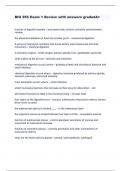
-
BIO 256 Exam 1 Review with answers gradedA+
- Examen • 5 pages • 2024
-
- €28,10
- + en savoir plus
BIO 256 Exam 1 Review with answers gradedA+ function of digestive system - processes food, extracts nutrients and eliminates residue the physical breakdown of food into smaller parts - mechanical digestion A series of hydrolysis reactions that break dietary macromolecules into their monomers - chemical digestion 6 accessory organs - teeth, tongue, salivary glands, liver, gallbladder, pancreas what makes up the gi tract - stomach and intestines mechanical di...
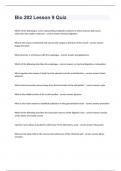
-
Bio 202 Lesson 9 Quiz well answered to pass
- Examen • 3 pages • 2024
-
Disponible en pack
-
- €9,21
- + en savoir plus
Bio 202 Lesson 9 Quiz well answered to pass Which of the following is a term representing metabolic reactions in which enzymes split macro molecules into smaller molecules - correct answer Chemical digestion What is the mucous membrane that secures the tongue to the floor of the mouth - correct answer lingual frenulum What structure is continuous with the esophagus - correct answer laryngopharynx Which of the following describes the esophagus - correct answer no chemical digestion or a...

Peur de manquer quelque chose ? Alors non !
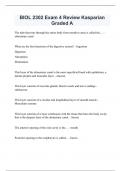
-
BIOL 2302 Exam 4 Review Kasparian Graded A
- Examen • 40 pages • 2024
-
- €12,43
- + en savoir plus
The tube that runs through the entire body from mouth to anus is called the.... - alimentary canal What are the four functions of the digestive system? - Ingestion Digestion Absorption Elimination This layer of the alimentary canal is the most superficial lined with epithelium, a lamina propria and muscular layer. - mucosa This layer consists of exocrine glands, blood vessels and nerve endings - submucosa This layer consists of a circular and longitudinal layer of smooth muscle. -...
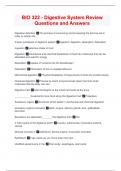
-
BIO 322 - Digestive System Review Questions and Answers
- Examen • 6 pages • 2024
-
Disponible en pack
-
- €8,75
- + en savoir plus
Digestion definition The process of consuming and processing the food we eat in order to sustain life 4 basic processes of digestive system Ingestion, digestion, absorption, defecation Ingestion selective intake of food Digestion mechanical and chemical breakdown of food into molecules that can be absorbed and used for energy Absorption Uptake of nutrients into the bloodstream Defecation Elimination of the un-useable leftovers Mechanical digestion Physical breakdown of large pieces of food...
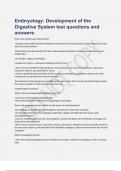
-
Embryology Development of the Digestive System test questions and answers
- Examen • 6 pages • 2024
-
- €13,36
- + en savoir plus
How is the primitive gut tube formed? -through craniocaudal and lateral folding of the embryo via the incorporation of the dorsal part of the yolk sac into the embryo The primitive gut tube extends from the oropharyngeal membrane to the cloacal membrane and is divided into... -the foregut, midgut, and hindgut Compare the adult vs. embryonic histology of the GI tract. -adult: mucosa (epithelial lining and glands, lamina propria, and muscularis mucosae), submucosa, muscularis externa,...
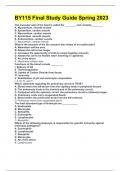
-
BY115 Final Study Guide Spring 2023
- Examen • 21 pages • 2023
-
- €10,59
- + en savoir plus
BY115 Final Study Guide Spring 2023 The muscular wall of the heart is called the ________ and contains________ A. Myocardium, smooth muscle B. Epicardium, cardiac muscle C. Myocardium, cardiac muscle D. Epicardium, smooth muscle E. Endocardium, cardiac muscle C. Myocardium, cardiac muscle What is the purpose of the bio concave disc shape of an erythrocyte? A. Maximizes surface area B. Allows the cell to live longer C. Increases the opportunity of cells to clump together prevents D...
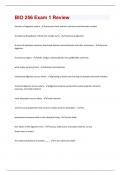
-
BIO 256 Exam | 68 Questions and Answers(A+ Solution guide)
- Examen • 6 pages • 2023
-
- €3,22
- + en savoir plus
function of digestive system - processes food, extracts nutrients and eliminates residue the physical breakdown of food into smaller parts - mechanical digestion A series of hydrolysis reactions that break dietary macromolecules into their monomers - chemical digestion 6 accessory organs - teeth, tongue, salivary glands, liver, gallbladder, pancreas what makes up the gi tract - stomach and intestines mechanical digestion occurs where - grinding of teeth and churning of stomach and small in...

Vous demandez-vous pourquoi tant d'étudiants portent de beaux vêtements, ont de l'argent à dépenser et profitent de beaucoup de temps libre ? Eh bien, ils vendent sur Stuvia ! Imaginez que vos notes d'étude soient téléchargées une dizaine de fois pour 15 € pièce. Chaque. Jour. Découvrez tout sur gagner de l'argent sur Stuvia

